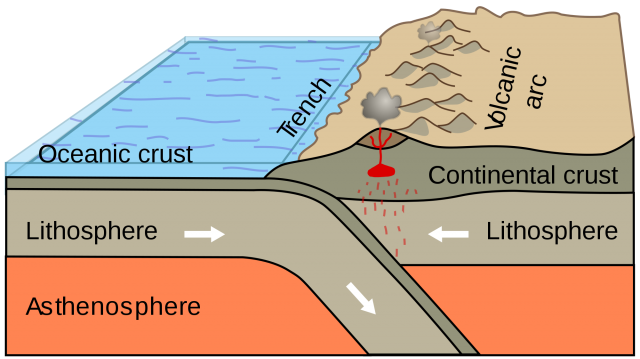orogeny
OROGENY, A GEOLOGIC CONCEPT, comes from the Greek oros, meaning “mountain,” and genes, meaning “stemming from.” The etymology associates the term with the concept of building mountains, and in the past, orogeny was associated with mountain formation. Its specific use, today however, relates to the deformation of rocks that leads to postorogenic mountain building. The thrusting, folding, and faulting of crustal plates form structures within fold belts (referred to as mountain ranges). When one plate moves under another, there is uplift, or stacking, which is termed epeirogeny. Epeirogeny is the actual formation of mountains.
The theory of plate tectonics explains the action of volcanoes, earthquakes, continental drift, and oceanbasin widening. The Earth's lithosphere contains the crust and upper portion of its mantle. Twelve or more plates comprise the principal regions of oceanic and continental crust. Plate tectonics involves the formation, lateral movement, interaction, and destruction of the lithospheric plates. These plates become stressed, and in fact break, causing wrinkles and folds. The process of plate movement relieves the Earth's core buildup of internal heat, thus creating many of the Earth's structural formations.

One theory in support of plate tectonics is that convection in the mantle drives sea-floor spreading and continent formation. Orogenous deformation of rocks occurs because of the crust movement. Pressure within the crust results from upper-layer rock weight as this weight compresses the lower layers. Because of crustal movement, rocks at the surface crack and fragment, referred to as joints, whose fracture lines are called faults. Rock displacement creates horizontal and vertical fault lines. Plates overriding or sliding against each other produce the Earth's crustal instability.
New oceanic lithosphere forms through volcanism in the form of fissures at mid-ocean ridges. Heat escapes the interior as this new lithosphere emerges from below, causing plate divergence or ocean-floor spreading. The lithosphere gradually cools, contracts, and moves away from the ridge, traveling across the seafloor to subduction zones. The existence of younger rock near these ridges is considered proof of continuous seafloor spreading.
Convergent oceanic plates overriding each other become heavier at one end and plunge as much as 62 mi (100 km) into the mantle. The edges of the plates melt from the intense heat and rise to the surface as molten rock. The colliding plates produce deep ocean trenches or subduction zones. Magma rises from the mantle to the ocean floor, creating continental rift valleys and plateaus of basalt. These processes create volcano mountain formations from lava accumulation on the ocean floor.
Transform-fault boundaries become earthquake zones because of plates sliding horizontally against each other. Most of these faults found on the ocean floor are associated with divergent plate boundaries, while other trenches form convergent plate boundaries. Earth instability generates the tremors of plate movement.
The continental lithosphere is about 62 mi (100 km) thick, with a low-density crust and upper mantle. Because of their granite composition, continental plates tend to be more porous and thus float above the oceanic plates. When the heavier (stacked) oceanic plates plunge into the mantle, the continental plates move along with the oceanic plate movement.
Continents move laterally as convection cells move upward, away from hot mantle zones toward cooler ones. This process is known as continental drift. Continental drift was believed to occur when North America and South America split apart from Eurasia and Africa. Because of this split, the once-small ATLANTIC OCEAN is now the second-largest ocean, covering onefifth of the Earth.
There are active fractures along the Mid-Atlantic Ridge that continually open and release lava flow. These rock-formed ridges continually move the continental plates by broadening the ocean basins. Another form of movement is when one continental plate overrides another. This type of movement, over periods of geologic time, forms high mountains on the Earth's surface.